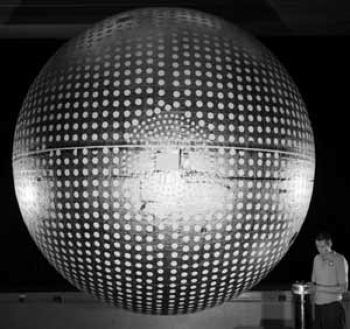
Home - Search - Browse - Alphabetic Index: 0- 1- 2- 3- 4- 5- 6- 7- 8- 9
A- B- C- D- E- F- G- H- I- J- K- L- M- N- O- P- Q- R- S- T- U- V- W- X- Y- Z
ADE
 Explorer 39 Credit: Manufacturer Image |
Status: Operational 1963. First Launch: 1963-12-19. Last Launch: 1968-08-08. Number: 3 . Gross mass: 8.00 kg (17.60 lb).
NASA NSSDC Master Catalog Description
Explorer 24 AD-B was placed in orbit together with Explorer 25 from a single launch vehicle. Explorer 24 was identical in configuration to the previously launched balloon satellites Explorer 9 and 19. The spacecraft was 3.6 m in diameter, was built of alternating layers of aluminum foil and plastic film, and was covered uniformly with 5.1-cm white dots for thermal control. It was designed to yield atmospheric density near perigee as a function of space and time from sequential observations of the sphere's position in orbit. To facilitate ground tracking, the satellite carried a 136-MHz tracking beacon. The satellite reentered the earth's atmosphere on October 18, 1968.
NASA NSSDC Master Catalog Description
Explorer 39 / AD-C was an inflatable sphere, 3.6 m in diameter. It was orbited to make atmospheric density determinations. The spacecraft was successfully launched into a nearly polar, highly elliptical orbit. It was folded and carried into orbit, together with ejection and inflation equipment, as part of the payload of Explorer 40. Two density experiments were performed. One involved the study of systematic density variation, and the other was concerned with nonsystematic density changes. The upper atmospheric densities were derived from sequential observations of the sphere by use of an attached 136.620-MHz radio tracking beacon and by optical tracking. The radio beacon ceased transmitting in June 1971. Since that time it has been necessary to rely solely on the SAO Baker-Nunn camera network for tracking. Explorer 39 has an expected orbital lifetime of 50 years.
NASA NSSDC Master Catalog Description
Explorer 19 AD-A was the second in a series of 3.66-m inflatable spheres placed into orbit to determine atmospheric densities. Explorer 19 was launched while Explorer 9, the first satellite in the series, was still active, so that densities in two different portions of the atmosphere were sampled simultaneously. The satellite consisted of alternating layers of aluminum foil and plastic film. Uniformly distributed over the aluminum outer surface were 5.1-cm dots of white paint for thermal control. A 136.620-MHz tracking beacon, which was powered by four solar cells and was mounted on the spacecraft skin, used the electrically separated hemispheres of the balloon as an antenna. The spacecraft was successfully orbited, but its apogee was lower than planned. The beacon did not have sufficient power to be received by ground tracking stations, making it necessary to rely solely on the SAO Baker-Nunn camera network for tracking.
Family: Atmosphere sat, Earth. Country: USA. Launch Vehicles: Scout, Scout X-4, Scout B. Projects: Explorer. Launch Sites: Vandenberg, Vandenberg SLC5. Agency: NASA. Bibliography: 2, 279, 3712, 3717, 6.
1963 December 19 - . 18:49 GMT - . Launch Site: Vandenberg. Launch Complex: Vandenberg SLC5. LV Family: Scout. Launch Vehicle: Scout X-4.
- Explorer 19 - .
Payload: ADE A. Mass: 7.00 kg (15.40 lb). Nation: USA.
Agency: NASA Langley.
Program: Explorer.
Class: Earth.
Type: Atmosphere satellite. Spacecraft: ADE.
Decay Date: 1981-05-10 . USAF Sat Cat: 714 . COSPAR: 1963-053A. Apogee: 2,391 km (1,485 mi). Perigee: 597 km (370 mi). Inclination: 78.60 deg. Period: 115.90 min.
In its first NASA use from Vandenberg AFB a Scout rocket (#122) was successfully launched. The 18-pound Explorer 19 atmosphere density satellite was successfully injected into orbit. 12 foot dia. balloon; identical to Explorer 9; atmospheric density studies. Spacecraft engaged in research and exploration of the upper atmosphere or outer space (US Cat B).
1964 November 21 - . 17:09 GMT - . Launch Site: Vandenberg. Launch Complex: Vandenberg SLC5. LV Family: Scout. Launch Vehicle: Scout X-4.
- Explorer 24 - . Payload: ADE B. Mass: 9.00 kg (19.80 lb). Nation: USA. Agency: NASA Langley. Program: Explorer. Class: Earth. Type: Atmosphere satellite. Spacecraft: ADE. Decay Date: 1968-10-18 . USAF Sat Cat: 931 . COSPAR: 1964-076A. Apogee: 2,498 km (1,552 mi). Perigee: 530 km (320 mi). Inclination: 81.40 deg. Period: 116.30 min. 12 foot dia. balloon; atmospheric density studies. Spacecraft engaged in research and exploration of the upper atmosphere or outer space (US Cat B). .
1968 August 8 - . 20:12 GMT - . Launch Site: Vandenberg. Launch Complex: Vandenberg SLC5. LV Family: Scout. Launch Vehicle: Scout B.
- Explorer 39 - . Payload: ADE C. Mass: 9.00 kg (19.80 lb). Nation: USA. Agency: NASA Langley. Program: Explorer. Class: Earth. Type: Atmosphere satellite. Spacecraft: ADE. Decay Date: 1981-06-22 . USAF Sat Cat: 3337 . COSPAR: 1968-066A. Apogee: 2,538 km (1,577 mi). Perigee: 670 km (410 mi). Inclination: 80.70 deg. Period: 118.30 min. Air Density Explorer; atmospheric density and temperature data. Spacecraft engaged in research and exploration of the upper atmosphere or outer space (US Cat B). .
Back to top of page
Home - Search - Browse - Alphabetic Index: 0- 1- 2- 3- 4- 5- 6- 7- 8- 9
A- B- C- D- E- F- G- H- I- J- K- L- M- N- O- P- Q- R- S- T- U- V- W- X- Y- Z
© 1997-2019 Mark Wade - Contact
© / Conditions for Use